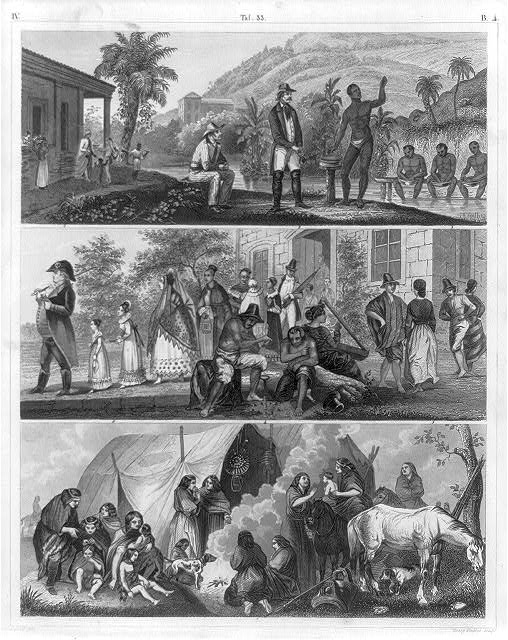
Summary of Engraving
Art is often a unique way of learning about historical events and ways of life in the past. While they can be biased and inaccurate, art can offer different perspectives and provide more room for interpretation than writing. In this engraving from 1851, three aspects of Brazilian life during this era are depicted. The first panel in this engraving portrays a Brazilian plantation with well-dressed white men talking to African workers or slaves working in a river. A family plays in the background, surrounded by several houses and rolling hills. In the second panel, a wealthy family walks to Mass while several people of various dress stand in front. The third panel depicts a Patagonian camp with several women talking to each other, taking care of children, or standing by a fire.
Artist
The artist of this engraving is Jean-Baptiste Debret, who was a French neoclassical painter. His work often centered around the social relations he saw while living in Brazil for fifteen years. His works surrounding Brazilian life were often neutral, depicting moments in time rather than sending a political message. However, he always sought to include people from oppressed groups, such as slaves, women, and indigenous people. In this engraving, he uses the beautiful scenery of Brazil to contrast the social relations being depicted. In the first panel, the rolling mountains contrast the oppressive relationship between the plantain owners and the slaves, whereas, in the last panel, the main focus is the indigenous women with almost no nature shown. This difference shows how different groups of people were granted different levels of freedom at this time in Brazil. Slaves had the most restrictions, yet they are painted with the most amount of nature. This a strong statement from Debret on the social relations within Brazil and how oppressive they were.
Background Information
Brazil was slow to eradicate slavery and plantations remained the main source of income for the area. Brazilian independence came much later than the rest of Latin America and a monarchy with heavy Portuguese influence governed, thus slowing the progress towards racial equality and a democratic government. This engraving was created in the beginning of the “Progress” era, which was from 1850 to 1880, and depicts these inequalities and radical social differences between the wealthy class, slaves, and indigenous groups. The engraving offers unique perspectives on life in Brazil during this time, while also portraying the multitude of issues present during that time.
Works Cited
fig. 1 Brazilian plantation; fig. 2, 3 Diamond washing; fig. 4, 5 Brazilian sports; fig. 6, Brazilian planter’s family walking to mass; fig. 7 Patagonian camp. , 1851. Photograph. https://www.loc.gov/item/2006679891/.
Chasteen, John Charles. Born in Blood and Fire. 4rd edition. New York: W.W. Norton, 2016.
“Jean-Baptiste Debret.” Artnexus, www.artnexus.com/en/news/5d5c1ae3c70855f6b9ef720e/jean-baptiste-debret.
